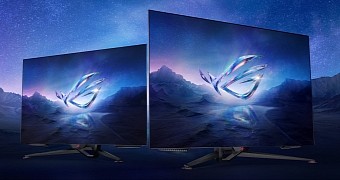Asus used this year’s CES to also take the wraps off a pair of new monitors, both specifically aimed at gamers and coming with impressive specs.
First of all, it’s the 42-inch ROG Swift OLED PG42UQ, which the company describes as the world’s first 42-inch OLED gaming monitor. And then, it’s the 48-inch ROG Swift PG48UQ, an even larger model with reduced glare and a Micro-texture coating specifically supposed to allow for the perfect gaming experience.
The company guarantees more accurate colors and less on-screen distraction, with an increased focus on dealing with the heat these screens typically struggle with.
“One design challenge with OLED panels is heat dissipation. Since excessive heat can affect product lifespan, it’s not uncommon for TV manufacturers to cap brightness levels in order to keep operating temperatures around 60° C,” Asus explains.
“We drew on our extensive experience with cooling motherboards, graphics cards, and laptops to design a custom cooling solution for the ROG Swift OLED series. A large custom heatsink and a carefully planned interior airflow layout maximizes heat exchange to keep operating temperatures below 50° C. That thermal headroom lets these monitors offer a peak brightness of 900 nits, while limiting burn-in for reliable long-term performance.”
No launch date just yet
The new monitors come with two HDMI 2.1 ports and two HDMI 2.0 connectors, one DisplayPort 1.4, and a USB hub.
“Unlike most HDMI 2.1 monitors, though, ROG Swift OLED displays use fixed-rate link (FRL) tech to unlock the full 48Gbps bandwidth of the new HDMI specification. That means you can game at 4K and 120Hz on the latest gaming consoles, all without chroma subsampling blurring the image,” Asus.
There’s no estimate as to when the new monitors could become available for gamers worldwide, and Asus has also remained tight-lipped on the pricing of the two devices. But of course, they’re very likely to be quite expensive, especially given such a piece of technology is still rare these days.

 14 DAY TRIAL //
14 DAY TRIAL //